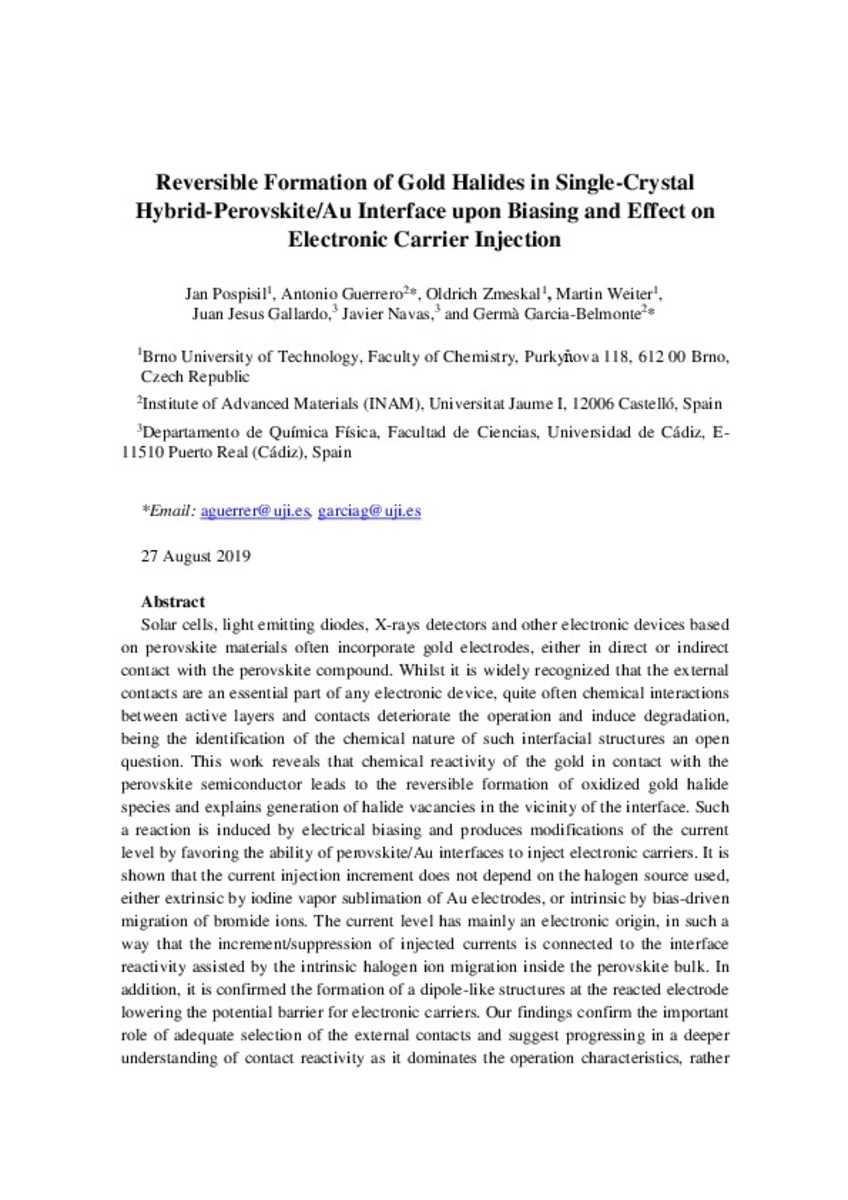Mostra el registre parcial de l'element
Reversible Formation of Gold Halides in Single‐Crystal Hybrid‐Perovskite/Au Interface upon Biasing and Effect on Electronic Carrier Injection
| dc.contributor.author | Pospisil, Jan | |
| dc.contributor.author | Guerrero, Antonio | |
| dc.contributor.author | Zmeskal, Oldrich | |
| dc.contributor.author | Weiter, Martin | |
| dc.contributor.author | Gallardo Bernal, Juan Jesus | |
| dc.contributor.author | Navas, Javier | |
| dc.contributor.author | Garcia-Belmonte, Germà | |
| dc.date.accessioned | 2019-12-12T10:23:19Z | |
| dc.date.available | 2019-12-12T10:23:19Z | |
| dc.date.issued | 2019-08-08 | |
| dc.identifier.citation | Pospisil, J., Guerrero, A., Zmeskal, O., Weiter, M., Gallardo, J. J., Navas, J., Garcia‐Belmonte, G., Reversible Formation of Gold Halides in Single‐Crystal Hybrid‐Perovskite/Au Interface upon Biasing and Effect on Electronic Carrier Injection. Adv. Funct. Mater. 2019, 29, 1900881. https://doi.org/10.1002/adfm.201900881 | ca_CA |
| dc.identifier.issn | 1616-301X | |
| dc.identifier.issn | 1616-3028 | |
| dc.identifier.uri | http://hdl.handle.net/10234/185396 | |
| dc.description.abstract | Solar cells, light emitting diodes, and X‐ray detectors based on perovskite materials often incorporate gold electrodes, either in direct or indirect contact with the perovskite compound. Chemical interactions between active layers and contacts deteriorate the operation and induce degradation, being the identification of the chemical nature of such interfacial structures an open question. Chemical reactivity of gold in contact with the perovskite semiconductor leads to reversible formation of oxidized gold halide species and explains the generation of halide vacancies in the vicinity of the interface. Electrical biasing induces contact reaction and produces modifications of the current level by favoring the ability of perovskite/Au interfaces to inject electronic carriers. The current injection increment does not depend on the halogen source used, either extrinsically by iodine vapor sublimation of Au electrodes, or intrinsically by bias‐driven migration of bromide ions. In addition, the formation of a dipole‐like structure at the reacted electrode that lowers the potential barrier for electronic carriers is confirmed. These findings highlight adequate selection of the external contacts and suggest the need for a deeper understanding of contact reactivity as it dominates the operation characteristics, rather than being governed by the bulk transport properties of the charge carriers, either electronic or ionic. | ca_CA |
| dc.format.extent | 7 p. | ca_CA |
| dc.format.mimetype | application/pdf | ca_CA |
| dc.language.iso | eng | ca_CA |
| dc.publisher | Wiley | ca_CA |
| dc.relation.isPartOf | Advanced Functional Materials, 2019, vol. 29, no 32 | ca_CA |
| dc.rights | Copyright © John Wiley & Sons | ca_CA |
| dc.rights.uri | http://rightsstatements.org/vocab/InC/1.0/ | * |
| dc.subject | carrier injection | ca_CA |
| dc.subject | electrode reactivity | ca_CA |
| dc.subject | gold | ca_CA |
| dc.subject | hybrid perovskites | ca_CA |
| dc.subject | single crystal | ca_CA |
| dc.title | Reversible Formation of Gold Halides in Single‐Crystal Hybrid‐Perovskite/Au Interface upon Biasing and Effect on Electronic Carrier Injection | ca_CA |
| dc.type | info:eu-repo/semantics/article | ca_CA |
| dc.identifier.doi | https://doi.org/10.1002/adfm.201900881 | |
| dc.relation.projectID | Czech Science Foundation. Grant Number: 19‐23718S; MINECO of Spain. Grant Numbers: MAT2016‐76892‐C3‐1‐R, ENE2017‐90565‐REDT | ca_CA |
| dc.rights.accessRights | info:eu-repo/semantics/openAccess | ca_CA |
| dc.relation.publisherVersion | https://onlinelibrary.wiley.com/doi/full/10.1002/adfm.201900881 | ca_CA |
| dc.type.version | info:eu-repo/semantics/submittedVersion | ca_CA |
Fitxers en aquest element
Aquest element apareix en la col·lecció o col·leccions següent(s)
-
INAM_Articles [510]







